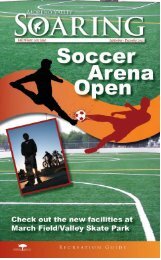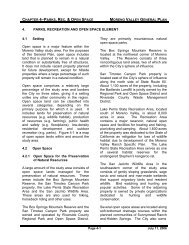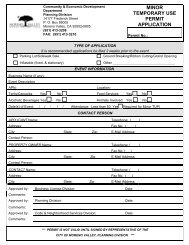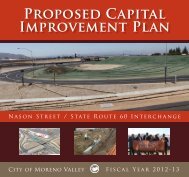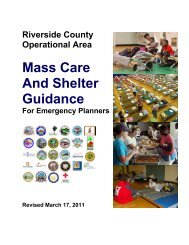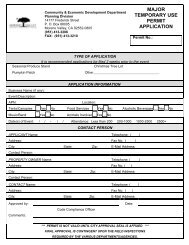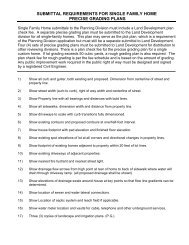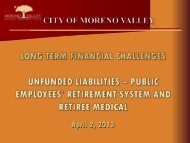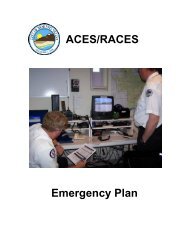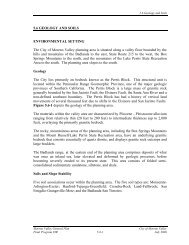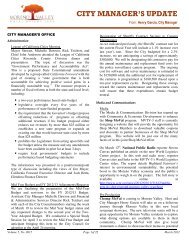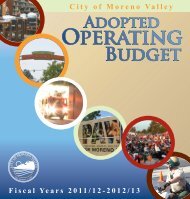General Plan - Moreno Valley
General Plan - Moreno Valley
General Plan - Moreno Valley
You also want an ePaper? Increase the reach of your titles
YUMPU automatically turns print PDFs into web optimized ePapers that Google loves.
CHAPTER 7 - CONSERVATIONdevelopment. Conditions of shallow depthto bedrock and rock outcroppings generallyoccur on the steeper slopes and are themost significant physical constraint todevelopment. Ripping may be required inorder to loosen weathered rock and blastingof hard rock may be required. Althoughintense urban and agricultural developmentof these soils would be constrained, lowintensity, large lot development is feasible.As development of the study area proceeds,soils will be exposed during gradingoperations. During this time, soils maybecome susceptible to water erosion andwind erosion. The extent that erosion wouldoccur depends on the particular soil, theextent of area being exposed, the slope, thetime of year grading operations occur anderosion control methods that are used.The use of septic tanks for sewage disposalis standard practice in the eastern portion ofthe <strong>Moreno</strong> <strong>Valley</strong> study area. The soils ofthe valley portion of the study area generallyhave only slight limitations for use withsubsurface sewage disposal systems.However, the steeper slopes andfloodplains are less suitable.None of the soil associations in the <strong>Moreno</strong><strong>Valley</strong> study area are significantly limited bysoil corrosiveness or shrink-swellcharacteristics that could affect theconstruction of roads, foundations ofstructures, or other urban uses.While the State of California and localagencies have advocated the preservationof prime agricultural soils for agriculturaluse, the retention of agricultural land is farmore complicated than identifying primeagricultural soils and requiring that theyused for agricultural purposes only.Agriculture is a business that exists onlywhere economics and area land use arefavorable toward animal and cropproduction. The issues affecting thepotential success of an agriculturalpreservation program include the availabilityMORENO VALLEY GENERAL PLANand cost of water, land use competition,urban/rural land use conflicts and theeconomics of agricultural production.7.5 WATER RESOURCES7.5.1 BackgroundThe early history of water in <strong>Moreno</strong> <strong>Valley</strong>began with the creation of the AlessandroIrrigation District in 1891. The irrigationdistrict was formed for the purpose ofimporting water from a reservoir in the SanBernardino Mountains. The reservoir wasoriginally built for the community ofRedlands.The community of <strong>Moreno</strong> was founded atthe intersection of Alessandro Boulevard andRedlands Boulevard in advance of the newwater supply. An aqueduct was completed,but the flow of water ended quickly due todrought and because there was not enoughwater for both Redlands and <strong>Moreno</strong>. Thecourts decreed that City of Redlands hadpriority water rights. By the turn of thecentury most of the early farmers andsettlers left the area. The farmers thatremained in the area relied on winter rainsand local wells.In 1919, the <strong>Moreno</strong> Mutual IrrigationCompany acquired wells in <strong>Moreno</strong> <strong>Valley</strong>and San Timoteo Canyon. Water wasdelivered from San Timoteo Canyon throughthe old aqueduct system until the 1954.Water agencies in the Yucaipa/Beaumontarea successfully challenged the company’sright to well water from that area.Groundwater no longer provides a significantpercentage of the local water supply. Thereare two hydrological groundwater basins inthe planning area. The Perris Basin is on thewestern side of <strong>Moreno</strong> <strong>Valley</strong>. The SanJacinto Basin is on eastern side of the studyarea.Box Springs Mutual Water Company servesa small portion of the community, while thePage 7-7 July 11, 2006



